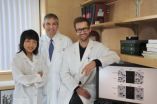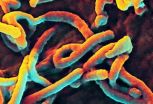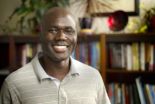(Press-News.org) MADISON, Wis. — Figuring out how blank slate stem cells decide which kind of cell they want to be when they grow up — a muscle cell, a bone cell, a neuron — has been no small task for science.
Human pluripotent stem cells, the undifferentiated cells that have the potential to become any of the 220 types of cells in the body, are influenced in the lab dish by the cocktail of chemical factors and proteins upon which they are grown and nurtured. Depending on the combination of factors used in a culture, the cells can be coaxed to become specific types of cells.
Now, in a new study published today, Sept. 8, in the Proceedings of the National Academy of Sciences, a team of researchers from the University of Wisconsin-Madison has added a new wrinkle to the cell differentiation equation, showing that the stiffness of the surfaces on which stem cells are grown can exert a profound influence on cell fate.
"To derive lineages, people use soluble growth factors to get the cells to differentiate," explains Laura Kiessling, a UW-Madison professor of chemistry and biochemistry and stem cell expert.
Past work, she notes, hinted that the qualities of the surface on which a cell lands could exert an influence on cell fate, but the idea was never fully explored in the context of human pluripotent stem cell differentiation.
In the lab, stem cells are grown in plastic dishes coated with a gel that contains as many as 1,800 different proteins. Different factors can be introduced to obtain certain types of cells. But even in the absence of introduced chemical or protein cues, the cells are always working to differentiate — but in seemingly random, undirected ways.
The Wisconsin group, directed by Kiessling and led by chemistry graduate student Samira Musah, decided to test the idea that the hardness of a surface can make a difference. After all, in a living body, cells seek different niches with different qualities and transform themselves accordingly.
"Many cell types grow on a surface. If a cell is near bone, the environment has certain features," says Kiessling, whose group — collaborating with UW-Madison colleagues Sean Palecek, Qiang Chang and William Murphy — has been working to produce precise, chemically defined surfaces on which to grow stem cells. "A cell will react differently if it lands near soft tissue like the brain."
To fully explore the idea that surface matters to a stem cell, Kiessling's group created gels of different hardness to mimic muscle, liver and brain tissues. The study sought to test whether the surface alone, absent any added soluble factors to influence cell fate decisions, can have an effect on differentiation.
Results, according to Kiessling, showed that a soft, brain tissue-like surface, independent of any soluble factors, was catalyst enough to direct cells to become neurons, the large elaborate cells that make up the central nervous system. Stiffer surfaces favored the stem cell state.
"We didn't change anything but switch from a hard surface to a soft surface," Kiessling says. "They all started looking like neurons. It was stunning to me that the surface had such a profound effect."
In the case of the soft, brain-like surface, the Wisconsin researchers believe that the mechanical properties of a surface are influencing a protein called YAP. YAP can be found in the cytoplasm but also the nucleus of a cell, and when it is in the nucleus, YAP regulates gene expression. According to the study results, YAP is excluded from the nucleus on the soft gels, and its depletion there helps drive the stem cells onto a brain cell developmental pathway.
The finding, that the simple mechanical properties of a surface can play a big role in helping stem cells decide what to be, promises to help scientists better define the experimental conditions to direct stem cell fate. It may also ultimately inform the methods that will be used for producing large quantities of cells for therapeutic use and other applications such as the high-throughput screening of chemicals for brain toxicity or therapeutics.
INFORMATION:
CONTACT: Laura Kiessling, 608-262-0541, kiessling@chem.wisc.edu
— Terry Devitt, 608-262-8282, trdevitt@wisc.edu
This study was supported by National Institutes of Health grants R01 GM49975, R01 EB007534 and R21 NS081484.
In directing stem cells, study shows context matters
2014-09-08
ELSE PRESS RELEASES FROM THIS DATE:
Co-flowing liquids can stabilize chaotic 'whipping' in microfluidic jets
2014-09-08
VIDEO:
This video show jets emerging from the same glass needle in chaotic whipping (left) and a steady state helical whipping. By controlling the viscosity and speed of the liquid surrounding...
Click here for more information.
Industrial wet spinning processes produce fibers from polymers and other materials by using tiny needles to eject continuous jets of liquid precursors. The electrically charged liquids ejected from the needles normally exhibit a chaotic "whipping" structure ...
Brain injuries no match for sPIF treatment
2014-09-08
New Haven, Conn. — Researchers at Yale School of Medicine and their colleagues have uncovered a new pathway to help treat perinatal brain injuries. This research could also lead to treatments for traumatic brain injuries and neurodegenerative disorders such as Alzheimer’s and Parkinson’s.
The findings are published in the Sept. 8 issue of Proceedings of the National Academy of Sciences.
The microRNA let-7 is known to cause the death of neurons in the central nervous system. The research team found that a synthetic molecule derived from the embryo called PreImplantation ...
Textbook theory behind volcanoes may be wrong
2014-09-08
In the typical textbook picture, volcanoes, such as those that are forming the Hawaiian islands, erupt when magma gushes out as narrow jets from deep inside Earth. But that picture is wrong, according to a new study from researchers at Caltech and the University of Miami in Florida.
New seismology data are now confirming that such narrow jets don't actually exist, says Don Anderson, the Eleanor and John R. McMillian Professor of Geophysics, Emeritus, at Caltech. In fact, he adds, basic physics doesn't support the presence of these jets, called mantle plumes, and the ...
UCLA biologists delay the aging process by 'remote control'
2014-09-08
UCLA biologists have identified a gene that can slow the aging process throughout the entire body when activated remotely in key organ systems.
Working with fruit flies, the life scientists activated a gene called AMPK that is a key energy sensor in cells; it gets activated when cellular energy levels are low.
Increasing the amount of AMPK in fruit flies' intestines increased their lifespans by about 30 percent — to roughly eight weeks from the typical six — and the flies stayed healthier longer as well.
The research, published Sept. 4 in the open-source journal Cell ...
Rapid and durable protection against ebola virus with new vaccine regimens
2014-09-08
One shot of an experimental vaccine made from two Ebola virus gene segments incorporated into a chimpanzee cold virus vector (called chimp adenovirus type 3 or ChAd3) protected all four macaque monkeys exposed to high levels of Ebola virus 5 weeks after inoculation, report National Institutes of Health (NIH) scientists and their collaborators. The ability of the ChAd3 Ebola virus vaccine to elicit rapid protection in monkeys is notable as the world health community battles an ongoing Ebola virus disease outbreak in West Africa. While the protective effects of the single ...
Teens living with 2 college-educated parents less likely to use alcohol and marijuana
2014-09-08
ARLINGTON, Texas -- A high school senior who lives with two college-educated parents is significantly less likely to drink alcohol or smoke marijuana than a teenager who lives with one parent, a new University of Texas at Arlington study has found.
For example, teens living with their mother only are 54 percent more likely to use alcohol, and 58 percent more likely to smoke if they live only with their father.
Eusebius Small, an assistant professor in the UT Arlington School of Social Work, analyzed data on 14,268 teenagers to determine the impact of family structure ...
Ohio University paleontologists discover new species of titanosaurian dinosaur in Tanzania
2014-09-08
ATHENS, Ohio (Sept. 8, 2014)—Ohio University paleontologists have identified a new species of titanosaurian, a member of the large-bodied sauropods that thrived during the final period of the dinosaur age, in Tanzania. Although many fossils of titanosaurians have been discovered around the globe, especially in South America, few have been recovered from the continent of Africa.
The new species, named Rukwatitan bisepultus, was first spotted by scientists embedded in a cliff wall in the Rukwa Rift Basin of southwestern Tanzania. Using the help of professional excavators ...
In one of nature's innovations, a single cell smashes and rebuilds its own genome
2014-09-08
Life can be so intricate and novel that even a single cell can pack a few surprises, according to a study led by Princeton University researchers.
The pond-dwelling, single-celled organism Oxytricha trifallax has the remarkable ability to break its own DNA into nearly a quarter-million pieces and rapidly reassemble those pieces when it's time to mate, the researchers report in the journal Cell. The organism internally stores its genome as thousands of scrambled, encrypted gene pieces. Upon mating with another of its kind, the organism rummages through these jumbled genes ...
Gobbling up poison: A method for killing colon cancer
2014-09-08
(PHILADELPHIA) – These days, cancer researchers aim to design targeted and specific therapy – those that kill cancer but spare the surrounding tissue. Immunotoxins, which use cancer-targeted antibodies linked to deadly toxins such as ricin, are one such therapy. However, few have succeeded to date in part because cancer cells share many molecules with normal cells, and because it can be challenging to unlock the deadly chemical only after the antibody has homed to the diseased tissue.
Now researchers at Thomas Jefferson University have discovered the unique biological ...
Soft robot squirms over fire, ice, and withstands crushing force
2014-09-08
ITHACA, N.Y. – Engineers have created a shape-changing "soft" robot that can tread over a variety of adverse environmental conditions including snow, puddles of water, flames, and the crushing force of being run over by an automobile.
Videos: https://cornell.box.com/softrobot
The engineers from Cornell and Harvard Universities will detail the robot in an upcoming edition of the journal Soft Robotics. An early online version of the study can be found at: http://online.liebertpub.com/doi/full/10.1089/soro.2014.0008
The pneumatically powered, fully untethered robot was ...






